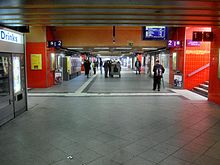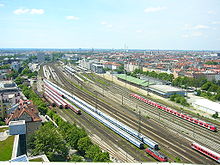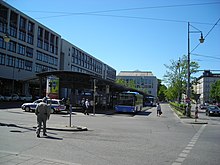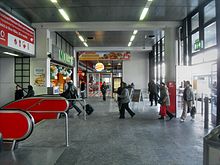Munich East train station
| Munich East | |
|---|---|
 Main entrance Orleansplatz
|
|
| Data | |
| Design | Through station |
| Platform tracks | 12 |
| abbreviation | MOP |
| IBNR | 8000262 |
| Price range | 1 |
| opening | 1871 (1985 new building) |
| Website URL | BEG station database |
| Profile on Bahnhof.de | Munich_Ost |
| location | |
| City / municipality | Munich |
| country | Bavaria |
| Country | Germany |
| Coordinates | 48 ° 7 '37 " N , 11 ° 36' 17" E |
| Railway lines | |
|
|
| Railway stations in Bavaria | |
The Munich East station of Deutsche Bahn in the Munich district of Haidhausen is an important transfer point for local and long-distance traffic . The through station 12 platform tracks is one of the 21 stations of the price class 1 of DB Station & service and is thus, together with the central station one of the two stations Munich this class.
The first station building was built in 1871 according to plans by Friedrich Bürklein as Haidhausen station for the two new railway lines to Simbach and Rosenheim . Today the station is one of three long-distance train stations in the Bavarian capital, along with Munich's main train station and Pasing train station . In the local transport timetables, it is listed as the Ostbahnhof .
On Orleansplatz front of the station (Northwest side) to the inner-city traffic can MVG in buses or trams are switched. Under the square is the metro station of the U5 . The three modes of transport are integrated together with the S-Bahn in the Munich Transport and Tariff Association (MVV). Other city bus lines stop on the southeast side of the Ostbahnhof on Friedenstraße.
history
The station was built as Haidhausen on May 1, 1871 with the route to Neuötting via Mühldorf am Inn . The route to Rosenheim followed on October 15, 1871 . After Haidhausen's incorporation in 1874, it was renamed Munich East Station on October 15, 1876 . In 1880 the construction of a central signal box began . In 1898 the line to Deisenhofen via Giesing was built , and in 1909 a connection to Ismaning and Munich-Schwabing . The latter was electrified in 1927, together with the Munich – Rosenheim connection, as the first line to touch the Ostbahnhof .
From 1912 to 1924, the new Munich East marshalling yard was built east of the passenger station . Together with the marshalling yard, the new Munich East depot was opened in 1924 , replacing the previous depot at the passenger station.
On May 24, 1926 - coming from Berchtesgaden - passenger train 820 stopped at around 10:30 p.m. in front of the closed entry signal into the station. The signal covering it showed “drive free” due to a mechanical error, although it had been set to “stop” by the signal box. 30 people lost their lives when train 814 hit the stationary train.
During the air raids on Munich in April 1944, the station was destroyed and only partially restored. In 1952 the construction of a temporary counter hall began. On June 22, 1959, the motorail train loading facility was put into service.

In May 1972 the S-Bahn network with the central trunk line that flows into it was put into operation. The present reception building was opened in 1985 and the travel center was redesigned in 1999 . In the summer and autumn of 2008, the facades of the main building and the adjoining post office were renovated.
The variant A of the project Munich 21 provided for the integration of a four-track tunnel from the main train station in the western head of the East Railway Station. With this solution, a maximum of ten platform tracks (plus S-Bahn) would have been required at the Ostbahnhof. As part of alternative B , a double-track tunnel was to be created between the main and east station, without any major changes to the platform area. Both tunnels would have been used by long-distance and regional trains.
The basis for the so-called “track plan conversion Ostbahnhof” was a contract concluded in 1998 between the Free State of Bavaria and Deutsche Bahn AG. The Federal Railway Authority approved the project as part of a planning approval process on April 29, 2003.
Conversions at the Ostbahnhof are part of the planning approval decision issued on May 30, 2006 for Section 3 A of the second trunk line . In the course of the 10-minute cycle, changes to the lane plan between Ostbahnhof and Leuchtenbergring were planned over the course of the 2nd main route in order to avoid changes to the lane plan. The Ostbahnhof electronic signal box , the new construction of platform C (with platform tracks 5 and 6) and the demolition of the existing platform B (tracks 3 and 4) are also part of this planning approval decision. The first partial commissioning of the signal box is planned for the end of 2023 (status: 2019). In the course of the second trunk line, an underground stop is to be created at the Ostbahnhof.
The Kultfabrik and the Optimolwerke were located behind the Ostbahnhof until 2016, and the Werksviertel has been built here ever since .
Track systems

There are a total of 17 tracks in the passenger station. Tracks 1 to 5 are reserved for S-Bahn traffic and bear the signs for Ostbahnhof , tracks 6 to 8 and 11 to 14 are for local and long-distance traffic and are designated as Munich East . Tracks 9, 10 and 15 are reserved for passing trains and do not have a platform. There are loading facilities for motorail trains on tracks 16 and 17 , which are also parked and cleaned here. The night train lines in the direction of Berlin and Hamburg start from Munich East.
traffic
Long-distance transport

Mainly EC / IC trains run from and towards Salzburg or Innsbruck as well as Italy, usually for onward travel via Munich Hbf to Frankfurt am Main . In addition, individual Railjet trains run towards Vienna . In addition, there is a daily night train to Berlin and Hamburg, as well as a seasonal car train to Hamburg.
The following long-distance transport lines run in Munich's Ostbahnhof as an example:
| line | route | Tact | |
|---|---|---|---|
| IC 26 |
Königsee: Hamburg-Altona - Hamburg - Hanover - Göttingen - Kassel-Wilhelmshöhe - Würzburg - Augsburg - Munich East - Berchtesgaden |
a pair of trains | |
| EC 32 |
Wörthersee: ( Münster (Westf) -) Dortmund - Essen - Düsseldorf - Cologne - Koblenz - Frankfurt - Mannheim - Heidelberg - Stuttgart - Ulm - Augsburg - Munich Hbf - Munich East - Salzburg - Klagenfurt |
a pair of trains | |
| IC 60 | Karlsruhe - Stuttgart - Ulm - Augsburg - Munich Hbf - Munich East - Salzburg | individual trains | |
| RJ / EC 62 | Frankfurt - Heidelberg - | Stuttgart - Ulm - Augsburg - Munich Hbf - Munich East - Salzburg (- Klagenfurt / Graz ) | Every 2 hours |
| Saarbrücken - Mannheim - | |||
| EC 89 | Munich Central Station - Munich East - Kufstein - Innsbruck (- Bozen - Verona - Venice / Bologna ) | Every 2 hours | |
Regional traffic
On the Munich – Mühldorf railway line , regional trains of the Südostbayernbahn run every hour , some of which go via Mühldorf to Simbach am Inn and Burghausen . In the rush hour, additional repeater trains run between Munich Ostbahnhof and Mühldorf every half hour. In addition, four Regional Express trains run daily with fewer stops between Munich Central Station and Mühldorf, two of which are connected to Simbach. During rush hour, the Südostbayernbahn also uses four direct regional trains from Munich East via Ebersberg to Wasserburg am Inn .
Since December 15, 2013, the trains of the Bayerische Oberlandbahn , which run under the brand name Meridian on the Munich – Rosenheim line, have stopped in Munich East . The trains run every hour from Munich to Salzburg and Kufstein . The trains to Salzburg run between Munich East and Rosenheim without stopping, while the trains to Kufstein serve all intermediate stops. In the rush hour , additional trains between Munich and Kufstein and between Munich and Traunstein sometimes run every half hour.
| Train type | route | Clock frequency |
|---|---|---|
| RE | Munich - Munich East - Mühldorf (- Simbach (Inn) / Burghausen) | individual trains |
| RB | Munich - Munich East - Mühldorf (- Burghausen) | Hourly |
| RB | (Munich -) Munich East (- Grafing train station ) - Ebersberg - Wasserburg (Inn) train station | four pairs of trains |
| M. | Munich - Munich East - Rosenheim - Traunstein - Freilassing - Salzburg | Hourly |
| M. | Munich - Munich East - Rosenheim - Traunstein | four pairs of trains |
| M. | Munich - Munich East - Grafing train station - Rosenheim - Kufstein | Hourly |
S-Bahn Munich
As the end point of the trunk line tunnel, all S-Bahn lines run at the Ostbahnhof with the exception of the S 20 line.
The S-Bahn station was redesigned as part of the Takt-10 project of the S-Bahn Munich to enable crossing-free train journeys. Tracks 1 to 3 lead into town and tracks 4 and 5 lead out of town. Tracks 3 and 4 are used exclusively for lines S 3 and S 7, which turn here . (These two lines run from here to behind Giesing in left-hand traffic; only there was enough space for a flyover structure , which was necessary as part of the double-track expansion of the Munich East – Deisenhofen railway line .) Track 5 serves the lines S 2, S 4, S 6 and S 8 to continue eastbound. The S 1 ends on track 4 and is used again on track 2. Tracks 1 and 2 continue to serve the S 2, S 4, S 6 and S 8 lines for arriving from the east and continuing to the city center.
Subway, bus and tram
In 1988, the Ostbahnhof underground station was opened under Orleansplatz to the north-west of the DB station. It is located on the U5 underground line extended from the city center to Neuperlach . At the same time, the entire Orleansplatz and the station forecourt were redesigned. It was u. a. a new bus station built, a well installed and the old tram turning system dismantled. Today the U5, tram line 21 , city bus lines 54, 55, 62, 100, 145, 148, 155 and X30 as well as regional bus line 213 stop here. Bus lines 190 and 191 start at the Ostbahnhof Friedenstraße stop at the back of the station.
| line | Line course |
|---|---|
|
|
Laimer Platz - Friedenheimer Straße - Westendstraße - Heimeranplatz - Schwanthalerhöhe - Theresienwiese - Central Station - Karlsplatz (Stachus) - Odeonsplatz - Lehel - Max-Weber-Platz - Ostbahnhof - Innsbrucker Ring - Michaelibad - Quiddestraße - Neuperlach center - Therese-Giehse-Allee - Neuperlach south |
|
|
Westfriedhof - Leonrodplatz - Munich University of Applied Sciences - Central Station - Max-Weber-Platz - Ostbahnhof - St.-Veit-Straße |
With the start of S-Bahn traffic in 1972, the Ostbahnhof became a transfer point between the S-Bahn and tram lines 14 (coming from the east from Berg am Laim), 24 (coming from the southeast from Neuperlach and Ramersdorf) and 21 (from Ostbahnhof in starting the city center). In 1980, the underground line from the city center to Neuperlach via Giesing was opened (former name: U8). Line 24 was therefore omitted, and there was no longer any direct travel from Ostbahnhof to Neuperlach - until the U5 was extended in 1988. In 1980, tram line 14 was extended into the city center instead of line 21, so that only one instead of three Tram lines served the Ostbahnhof. Line 14 was replaced by line 19 in 1984, which ran here until May 7, 2018. Tram 21 has been running since October 2018. Line N19 continues to run at night. The tram turning system, which was no longer required from 1980, was dismantled in the course of excavating the underground station.
Facilities
Services
The Ostbahnhof S-Bahn customer center and a Deutsche Bahn travel center are located in the first basement. Almost the entire front of the building, which faces Orleansplatz, is designed as an arcade, in front of which there are taxi stands and short-term parking spaces subject to a fee. A large part of the main building is used by the City of Munich as a social department (including parts of the city youth welfare office and a social civic center). The entrances are to be found on the ground floor and the first basement.
shops
There are around 20 shops in the Ostbahnhof, most of them in the shopping arcade on the first basement floor. There are also some shops on the ground floor of the main building and at the rear exit to Friedenstrasse. Most of the shops are also open on Sundays and public holidays. In addition to the retail trade, gastronomic businesses are particularly represented. There are numerous vending machines, e.g. B. for tickets, sweets, drinks, passport photos, cigarettes and credit cards for cell phones.
Forecourt
Seen from the main entrance there is a branch of the discounter Lidl to the right of the forecourt . After half-rounding the building you come to a branch of Post and Postbank . On the upper floors of this house, accessible from Orleanstrasse, there is a citizens' office of the city administration, formerly known as the registration office .
For a long time, the bus station and Orleansplatz were Munich's largest meeting point for socially marginalized groups and users of illegal drugs. After heated discussions - and against the will of the responsible district committee - surveillance cameras were installed on Orleansplatz in April 2007 and at the same time a massive presence of police patrols proceeded against the people there. After the Kontaktladen off in Orleansstrasse was closed, the problem groups perceived in this way have largely disappeared from the streets around the Ostbahnhof. The cameras were also removed again.
Next to the train station, the Munich S-Bahn has its headquarters, which also has its depot in the nearby Steinhausen district .
reception
Around 1920, the Italian-born painter Eugenio Tomasi (1873–1969) from Munich painted the Ostbahnhof. His work is now in the Munich City Museum .
See also
- List of stations with stops of Intercitys of Deutsche Bahn
- List of stops on the Munich S-Bahn
- List of train stations and stops in Munich
- List of Munich underground stations
literature
- Peter Lisson : hub of the south. Munich railway junction. Hestra-Verlag, Darmstadt 1991, ISBN 3-7771-0236-9 .
- Thomas Guttmann: Giesing and the railroad . Buchendorfer Verlag, Munich 1998, ISBN 978-3-927984-80-6 . P. 18ff: The tug of war around the Ostbahnhof
Web links
- Site plan on bahnhof.de (PDF; 0.71 MB)
- Tracks in service facilities (MOP) , DB Netz AG (PDF; 1.94 MB), track plan, DB Netz AG
- Location and tracks of the station on the OpenRailwayMap
- Area map and further information about the train station at mvv-muenchen.de
- Munich East in the BEG station database
- Further description of the underground station on u-bahn-muenchen.de
Individual evidence
- ↑ Station price list 2020. In: Deutsche Bahn. Deutsche Bahn, January 1, 2020, accessed on July 10, 2020 .
- ↑ Hans-Joachim Ritzau: From Siegelsdorf to Aitrang. The railway disaster as a symptom - a study of the history of traffic . Landsberg 1972, pp. 44, 154.
- ↑ City of Munich, Department for Urban Planning and Building Regulations (ed.): Decision of the Committee for Urban Planning and Building Regulations of June 19, 2002 . June 19, 2002, p. 6–8 ( online [PDF]).
- ↑ a b Federal Railway Office, Munich branch (ed.): Plan approval decision 2. S-Bahn main line Plan approval section 3 A Munich East (S-Bahn) / Munich Leuchtenbergring . Munich May 30, 2006, p. Cover, 21, 22 ( PDF file [accessed June 13, 2015]). PDF file ( Memento of the original from June 15, 2015 in the Internet Archive ) Info: The archive link was inserted automatically and has not yet been checked. Please check the original and archive link according to the instructions and then remove this notice.
- ↑ Changed planning for the second Munich trunk line . In: Eisenbahn-Revue International . No. October 10 , 2019, ISSN 1421-2811 , p. 549 .
- ↑ Autozug Hamburg-Munich seasonally by train4you Vertriebs GmbH. Retrieved January 24, 2017 .
- ↑ Area map of the train station (PDF) on mvv-muenchen.de, accessed on January 20, 2016.
- ↑ http://www.muenchen.de/rathaus/Stadtverwaltung/Sozialreferat.html
- ^ Bruckmann's Lexicon of Munich Art. Munich painting in the 19th and 20th centuries Century, Volume 6, Munich 1994, p. 421.




